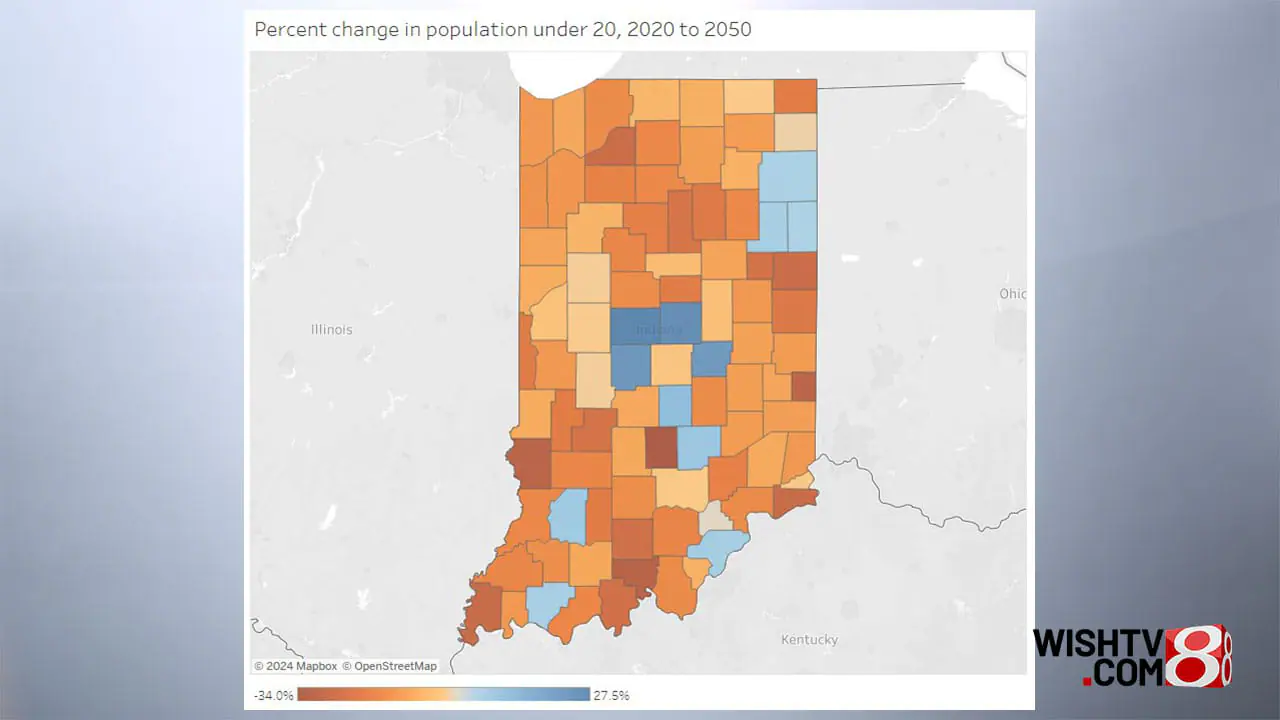Indiana to see ‘swift and severe’ slowdown in population growth
BLOOMINGTON, Ind. (WISH) — Indiana’s population growth will continue to lag through 2060 as the state’s births increasingly outnumber its deaths, researchers at Indiana University said Tuesday.
Matt Kinghorn, senior demographer for the Indiana Business Research Center at the Indiana University Kelley School of Business, said in a news release, “To underscore how swift and severe this change will be: Indiana’s total population growth over the next 40 years is projected to be lower than the state’s growth between 2000 and 2010.”
“Natural increase,” or the number of births exceeding the total of deaths, accounted for 70% of the state’s growth in the past decade.
But in the coming decade, “natural increase” will turn to “natural decrease” in Indiana.
“To some degree, this trend was always inevitable. With the aging of the baby boom generation — a cohort that today is between the ages of 60 and 78 — Indiana was sure to see a substantial decline in the natural increase, and with it, a slowdown in population growth.”
“Our projections show sharp decline in natural increase over the next 40 years and that the state will begin to see a natural decrease of the population — with deaths outnumbering births — beginning in the 2040s.”
People moving to Indiana will become Indiana’s only source of growth.
Another concerning trend will be the loss of working-age residents in the next 10 years, when 1 of every 5 will be older than the traditional retirement age.
Slowing population growth and “natural decrease” will be mean ever-smaller gains in the Indiana work force. Carol Rogers, director of the center, said in the release, “This is especially true among the prime working and household formation ages of 25 to 54. Indiana will need to exert magnetic attraction to bring in young people from places near and far, which puts us in direct competition with every other state facing slow to no growth.”
Indiana was estimated to grow by only 383,000 residents from 2020 to 2060, a 5.6% increase from the 2020 census count of 6,785,528.
Most of that growth will come from Hamilton County, Indiana’s fourth-largest county located just north of Indianapolis. Hamilton County in 2020 had 347,467 residents, and that total will increase by more than 180,500 from 2020 to 2050.
Kingman says Hamilton County will likely become Indiana’s second-largest county, overtaking Gary and Lake County, and Fort Wayne and Allen County.
The 11-county Indianapolis metro area will outgrow the state by adding nearly 405,000 residents from 2020 to 2050, a 19.3% increase.
The news release said, “The state’s five fastest-growing counties will be suburban Indianapolis counties, including Hamilton County. Boone, Hancock, Hendricks and Johnson counties will each grow by at least 25% by 2050, and Marion County will finally pass the 1 million mark.”
Marion County had 977,203 residents counted in the 2020 census.
Other notable items from the center’s latest estimates;
- 60% of Indiana’s population growth in the next 35 years will happen by 2030.
- The number of births in Indiana has steeply and steadily declined since 2008. The preliminary total of 79,000 births in 2023 represents a 12% decline compared to 2007. The 2023 tally will be the state’s third-lowest since 1946.
- The under-20 population will increasingly drop in midsize and rural counties through 2060.
- Indiana’s life expectancy peaked in 2010 and — except for a modest post-pandemic rebound — has declined since that peak. The primary reason: The state’s mortality rate for ages 25 to 54 increased by 24%, from 231.1 per 100,000 residents in 1998, to 287.3 per 100,000 residents in 2019. The COVID-19 pandemic, exacerbated by the continuing drug overdose crisis, fueled mortality rates for this group to much higher levels in 2020 and 2021.
- The mortality rate for Indiana’s working-age population in 2023 — at 304.2 per 100,000 residents — was 6% higher than it was in 2019.
